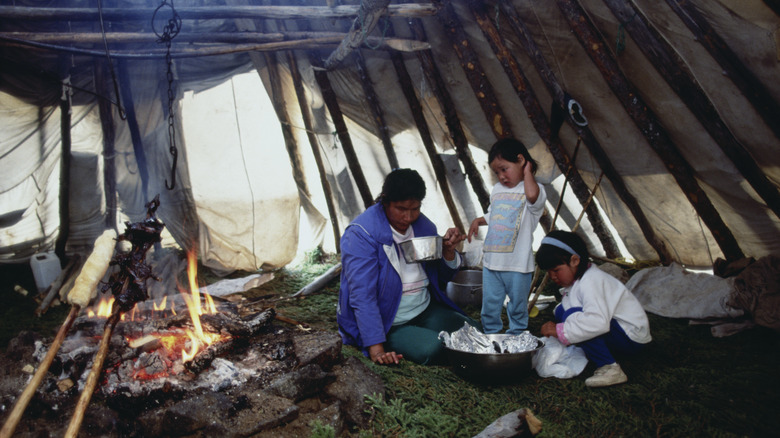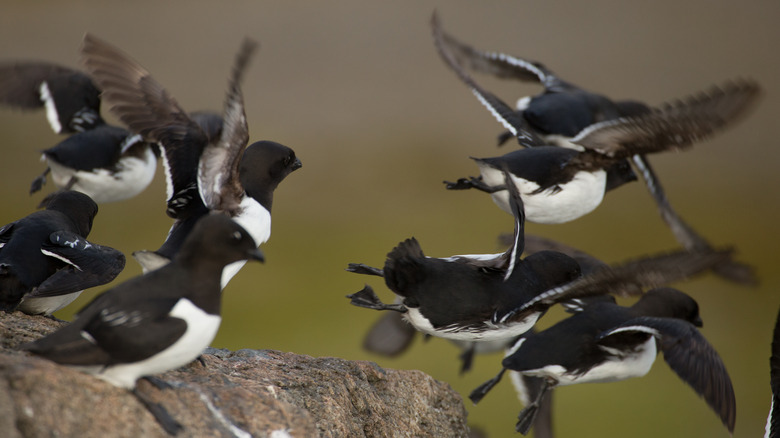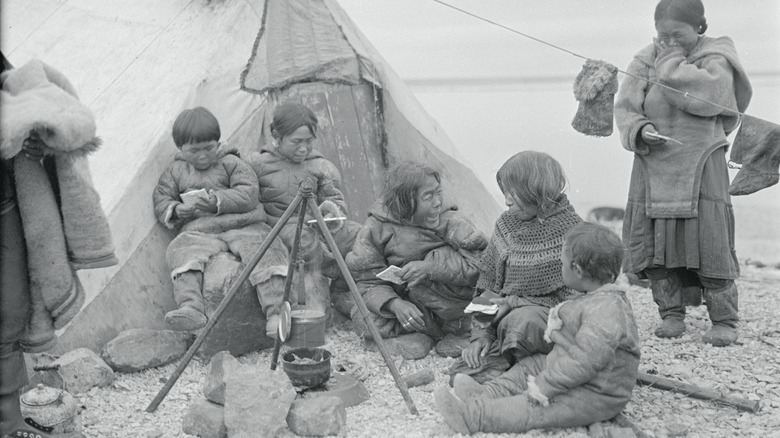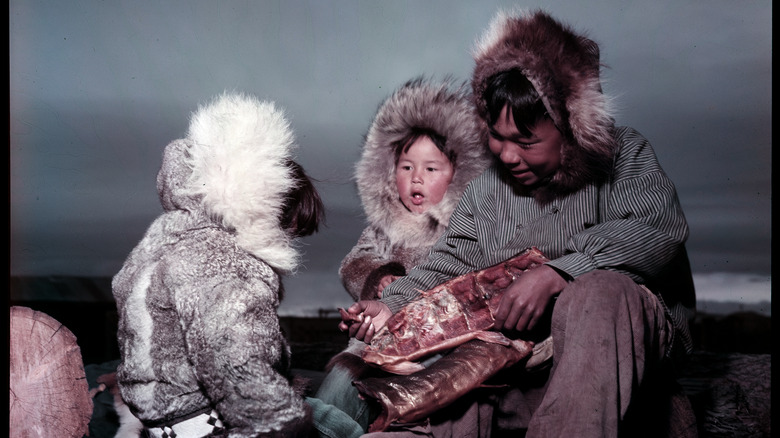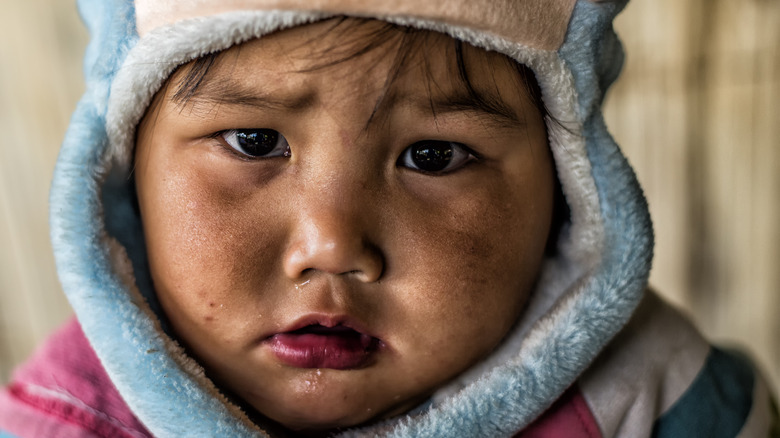Kiviaq: The Traditional Inuit Dish That Stuffs Hundreds Of Birds Into A Seal
If you're looking for something truly OTT for your holiday festivities, you could always go with a turducken, a dish with Cajun origins that may be the modern-day descendant of four and 20 blackbirds baked in a pie. (This, too, may have been a real thing back in the Middle Ages). Still, neither entree has anything on kiviaq, which is a Yuletime dish that you will probably only find should you be having Christmas dinner in Greenland.
Kiviaq, which was featured on the BBC1 series "Human Planet" back in 2011, consists of small seabirds that are left to ferment inside a seal skin for months at a time and then eaten, insides and all. This food may have evolved out of sheer necessity, as is the case with other Arctic specialties including the whale blubber snack known as muktuk. By now, however, the Inuit consider it to be a beloved holiday delicacy. While kiviaq may not have found favor with too many non-indigenous explorers and tourists who've visited Greenland over the years, those who go through the laborious task of making it year after year continue to find it well worth the effort.
How is kiviaq made?
Making kiviaq is a pretty labor-intensive process. It is necessary to first catch and then dispatch a seal, although from this animal only the skin is required so the meat can be put to other purposes. The next step involves catching seabirds with a tool called a kallut, which is a net on a long pole. Usually the birds are little auks, and you may need between 300 and 600 depending on the size of the sealskin. The birds, once caught and killed, are left in a shady spot to cool down before being stuffed into the sealskin. The skin is then sewn up and any gaps are filled in with larger birds called guillemots (these are also a type of auk).
At this point, you bury the stuffed sealskin in the ground, cover it with seal blubber as a fly repellent, and then cover the whole thing with rocks and let it sit for a long, long time. How long? Well, anywhere from three to 18 months ought to do it, although the birds are usually caught in late spring since this is when they are readily available. This should allow maybe 6 months of ferment time if you want the dish in time for the holidays, although true kiviaq connoisseurs may feel that only the nose knows for sure when it's done.
What is the history behind kiviaq?
Kiviaq is the kind of dish where you can't really pinpoint exactly who started making it and when, although seems to date back for several centuries if not millennia (the Inuit have been fermenting meat for thousands of years). What we do know, or can at least speculate with a fair amount of certainty, is why kiviaq came to be. The little auks are only abundant during the warmer months, at which time it's possible to catch thousands of them. One can only eat so many before the birds start to spoil, however, but fermentation is an effective method of preservation.
Yet another reason why the Inuit may have come up with a dish like kiviaq is for the nutritional benefits. Fermenting meat makes it easier to digest, and it can also deliver more concentrated doses of nutrients. What's more, fermentation allows the entire auk to be eaten, stomach contents and all. Historically, the Inuit diet has been primarily meat-based, so getting these second-hand nutrients is an important bonus, even if little auks are also carnivores who live off crustaceans. Still, neither fish nor fowl nor any other animal is readily available in Greenland in the wintertime, nor is it safe to go out hunting in the land of the midday gloom (that midnight sun thing comes at the opposite end of the year). As a result, kiviaq may have been quite literally a lifesaver in times gone by.
What does kiviaq taste like?
Kiviaq, as Greenlanders might say, is a taste of summer in the wintertime, although that flowery metaphor (which may sound better in Kalaallisut) doesn't do much to give us an accurate picture of the flavor. On the opposite end of the spectrum, we have food and travel writers who are horrified by the very idea and may rush to judgment by calling it "vile," "disgusting," or similar words without ever having tried it. We'll admit to not having sampled the dish ourselves but have attempted to unearth more neutral descriptions that might actually be construed as helpful.
From what we've been able to gather, kiviaq has a kind of sticky texture to it, and an odor that, as might be expected, is pungent. The flavor has been compared to strong cheese (blue, for example) as well as cured meats like salami, while some have been able to detect faint hints of licorice, as well.
How and when is kiviaq eaten?
While kiviaq is a traditional holiday food for the Inuit, it might also feature at other celebrations such as weddings. It's definitely the kind of thing you're going to want to serve a crowd, though, and due to the lengthy, labor-intensive preparation is very much a special occasion meal.
Even the process of eating kiviaq has a number of steps involved. The seal must first be opened, of course, and the birds extracted and distributed to the eaters. The feathers are first removed since no one wants to eat them. The birds may or may not be skinned at this point since although the skin is edible, there are those who prefer to eschew rather than chew the stuff. Once prepped, the proper way to eat a fermented auk is similar to how you eat a crawfish -– bite the head off and suck down the juice inside. The bird meat is then eaten as-is, including the guts, and there are many who find the heart to be the very best part. Sometimes, however, the fluid inside the intestine may be poured out and saved to be used as an ingredient in sauces for other foods.
Improperly-prepared kiviaq can be dangerous
While most who eat kiviaq come away unscathed and many are eager to eat it again, there have been a few instances over the years where the dish has had deadly consequences. The first and most prominent death attributed to kiviaq was that of polar explorer Knud Rasmussen, who passed away in 1933. While he died from flu and pneumonia, these may have been complicated by a case of food poisoning he's alleged to have contracted after dining on fermented auk. More recently, a man in the Greenland settlement of Siorapaluk died in 2013 from eating kiviaq made with eider and it's thought that these larger birds may not have fermented as well as the smaller little auks typically used. To compound the tragedy, the leftover kiviaq was served at his funeral (at the time, his death was attributed to other causes) and his daughter, too, succumbed.
Let it be said, though, that even seemingly benign foods such as undercooked rice, ice cream, and cheese have also caused fatal food poisoning, while the absolute worst food recall of all time involved cantaloupe linked to 43 deaths. This is a kill count approximately 1300% higher than the three deaths attributed to kiviaq, and yet few of us are frightened by the thought of eating raw cantaloupe. Should you ever have a chance to try kiviaq, you may base your decision on a number of factors, but food safety concerns need not necessarily be a deal breaker.
